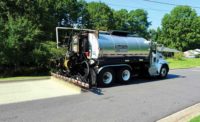A Canadian company’s “smog-eating” highway noise wall technology, aimed at trapping air pollutants emitted by vehicles, is currently being tested on highways in Toronto and the U.K. Proponents say it can reduce overall air pollution by 50%.
The technology, called SmogStop Barrier, features a double-walled design with an angled baffle to direct traffic emissions between the two wall segments where a photocatalytic coating breaks down pollutants. The wall also generates air vortices and enhances vertical mixing of emissions with cleaner air, further decreasing pollution levels, according to provider Envision SQ.
The Ontario Ministry of Transportation allowed a 15-meter-long, 6.5-m-high test section to be installed along Highway 401 in Toronto, and the results were monitored for eight months, says David Wood, senior researcher with Envision SQ.
“[The emissions] that come off tailpipes, those are channeled into the airspace to react with the coating and are converted to nitrogen and oxygen,” Wood says. “Cleaner air comes out of a gap at the bottom of the wall. It’s a solution that takes roadside air and, either through the action of the airflow or through the coating, substantially reduces pollution up to 150 meters beyond the wall.”
The structure consists of 15 clear acrylic panels topped by an aerodynamically designed opening that leads polluted air through the double-walled barrier. The opening at the top leads to a 25-cm air channel that separates the outer and inner walls.
Advanced computer models and wind tunnel tests conducted by Western University and the University of Guelph confirmed that SmogStop can reduce overall traffic emissions in downwind neighborhoods by 58% compared with conventional noise barriers, the company says.
“There was a really good reduction in the amount of nitrogen coming into the wall versus what was leaving—fifty percent,” says Bill Van Heyst, associate dean at the College of Engineering and Physical Sciences at the University of Guelph.
The tests, according to Envision SQ, showed that nitrogen oxide levels were reduced during daytime by an average of 49%. The wall system’s photocatalyst is activated by sunlight, and it also can respond to highway lighting during the night.
A second test segment about 100 m long and 3.5 m high of the SmogStop Barrier has been installed on a roadway in England. The wall is currently being monitored, but the trial is hindered by the ongoing COVID-19 pandemic, explains Wood.
“Right now we’re working with Canadian and U.S. transportation departments to introduce the product,” he says.
Van Heyst says the company and universities are also looking at the product’s potential to kill viruses, including COVID-19, via the air filtration systems in buildings.
Steve Barnes, business development manager with Gramm Barriers U.K., says the company formed the partnership with Envision SQ to test the walls in Europe, and he confirmed that testing results are delayed to later this year. However, “we see huge potential as we already have had inquiries from Spain, Italy, France and the Middle East,” says Barnes.






Post a comment to this article
Report Abusive Comment